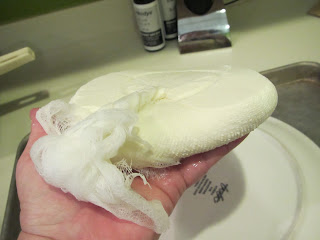I'm not sure why, but there is a lot of mystique surrounding the idea of making your own stock, which, in my humble opinion, is one of the cornerstones of many home-cooked meals. Basically, stock is some combination of bones and water, or vegetables and water. If you like soup (and who does not??) let me tell you: you NEED to know how to make stock, and it really couldn't be easier.
There are many kinds of stock: poultry, fish, meat, and vegetable, or some combination thereof.
Let's begin with a combination poultry-vegetable stock.
Here is one little tip: after you prep vegetables and herbs for a dish, take some of the scraps, and I'm talking about onion skins, parsley stems, mushroom stems, and toss them into an old plastic grocery or ziploc bag and into the freezer. The same with bones, although I would probably separate the richer bones such as steak or lamb, from things like chicken bones. The same applies to fish bones, or, you can ask your friendly fish monger at the market to save you some fish heads/bones after prepping an order. I use bones of milder fish, such as snapper, and veer away from stronger tasting fish, such as salmon, for making stock. Save the shrimp shells in a ziploc bag in your freezer and toss them in with the other fish bones for stock. Get the idea? It is really a cheap, easy way to make something wonderful!
Tonight I made a wonderful roast chicken for dinner. Since it was just my husband and I, I knew I would have leftover meat. First, turned the oven back on to 350'F and allowed it to heat up while I picked the meat from the carcass and stored it in the refrigerator for a future meal. Next, I tossed the bones into a shallow baking pan and roasted them for about 15-20 minutes.
Roasting is optional, but it seems to enhance the flavor quite a bit. If you want to skip this step, simply toss the bones into a pot that is deep enough to cover the bones. Turn the stove to a low heat and add whatever vegetable scraps you have on-hand. In my case, I had some onion scraps, a couple of garlic, stems from some Italian parsley, and I also added 3 dried bay leaves, a small amount of black peppercorns, a few coriander seeds, and 2 cardemom seeds (I really don't know yet if this is a good idea).
I decided to pick a stem of rosemary from one of our prolific bushes in the garden. Since it is so strong I chickened-out and only put a few "needles" into the stock pot.
I also added about a cup of white wine that was left over from an earlier dish. Adding white wine to fish, chicken, or vegetable stock adds depth to the flavor, and adding red wine (just a bit!) to your red meat bones stock adds flavor. Just don't overdo the wine. And add the same wine you would drink. DO NOT use that horrid, vile cooking wine. Just say no.
As to the herbs: use what you have, and add what is in season.
Do NOT add salt. Think of your stock as a "blank slate" to which you add more seasonings in the final dish. This is one of the ways that stock varies from broth.
How long should stock simmer? Simmer is the key word: don't boil. Well...how long do you have?! With fish/seafood stock, an hour is ideal. Poultry is great if it simmers a minimum of 2 hours, but if you can allow it to simmer up to four hours, so much the better. Beef. lamb and game can go longer.
Skim the surface of the stock occasionally to remove any foam that comes to the surface.
Once you are satisfied with the amount of time you have allowed the stock to simmer, remove it from the heat and allow it to cool a bit. Strain with a fine strainer, perhaps even lining the strainer with cheesecloth. Be careful if the contents are still warm!
After straining you may continue to reduce the stock with further simmering. Of course, reducing the stock intensifies the flavor and it will take up less room in your refrigerator/freezer. You can always reconstitute it with water when preparing to use it in a dish. Reduced stock is wonderful for things like pan sauce and gravy. It can be frozen in ice cube trays and the cubes dumped into a ziploc bag for storage in the freezer. A few chunks of this will transform any soup: guaranteed!
Or, you may wish to store just finished stock in plastic containers that should be (first) chilled in the refrigerator and subsequently frozen. Freshly prepared stock should be used within a couple of days or frozen as soon as chilled. It is good for up to 6 months in the freezer, longer if stored in a deep freezer.
strained chicken & vegetable broth, ready for the refrigerator!
......the next day.....
I put the stock back in the large stockpot and gradually reduced the liquid volume.
Note how much deeper the color appears.
I reduced the stock about 75%. Now I'm pouring the stock into ice cube trays.
I will pop these into the freezer.
Once frozen, I'll pop them out of the trays and into a ziploc bag for easy storage and use.
Try it!























































